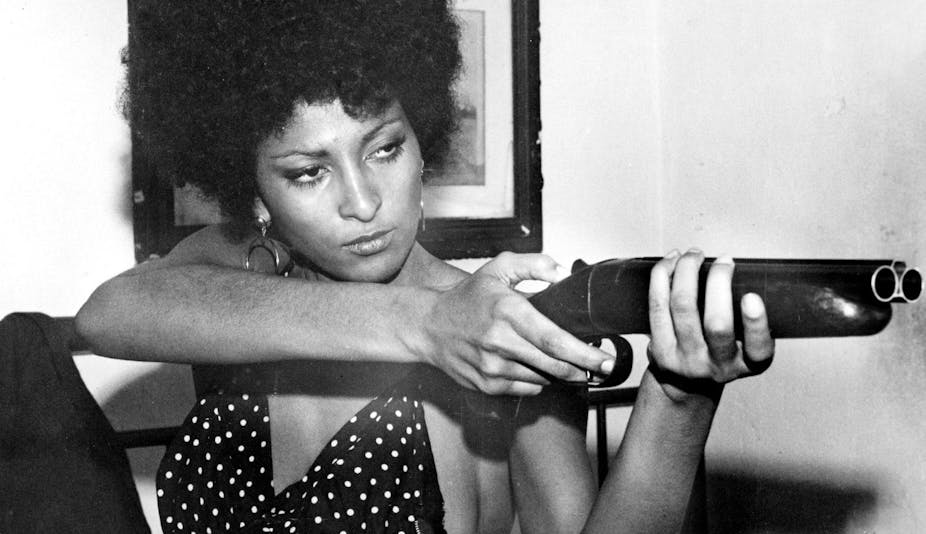When Pam Grier’s breakthrough movie Coffy was released in 1973, American International Pictures was clearly confident that her eponymous character was a supercharged heroine who would excite filmgoers.
“She’s the ‘GODMOTHER’ of them all!”, exclaimed the poster, linking the African-American Coffy to Marlon Brando’s Don Corleone in The Godfather (released the previous year). More enthusiastically still, the poster also called her “The Baddest One-Chick Hit-Squad That Ever Hit Town!”
Grier’s starring role in Coffy marked an upgrade in her screen status, following a series of smaller roles in exploitative prison flicks. Her proficiency in energetic action sequences and her openness to frank bodily display made her a perfect fit for American cinema in an era permitting more violence and nudity on screen than before. But Coffy saw her for the first time as the main propulsive force in a Blaxploitation movie.

A label more popular than scholarly, Blaxploitation captures the wave of low-budget, black-character-centred films that emerged from Hollywood in the first half of the 1970s. This cinematic movement was simultaneously reactionary and progressive, manifesting in the same instant both restrictive effects and liberating gestures.
On the one hand, Blaxploitation was the product of a studio system that was still white-dominated, with relatively few African-American executives, producers and directors. The films were not so much clear political statements as nakedly commercial ventures, characterised by low production values and familiar genre codes.
But on the other, the movies highlighted African-American agency and creativity. Crude and cartoonish though many of them were, they were nevertheless more Malcolm X than Martin Luther King in atmospherics, with protagonists who preferred to defeat whites than build multiracial alliances.
Coffy embodies the contradictions of Blaxploitation in a highly concentrated form. The film’s 50th anniversary allows us to reassess this vein of filmmaking and, more particularly, to think about the mixed politics of Grier’s own star image.
A liberated woman
In her day job, Coffy is a nurse engaged in emergency care. Outside working hours, however, she embarks on a one-woman crusade to annihilate the drug dealers who have rendered her young sister comatose and brought misery to many in the black community.
According to her lover, African-American politician Howard Brunswick, Coffy is a liberated woman. Just as she does in later Blaxploitation films such as Foxy Brown (1974) and Sheba, Baby (1975), Grier dispenses with legal niceties as she dynamically sets about remedying her people’s ills. Nevertheless, a sense of constriction, as well as liberation, is still apparent in her screen persona.
Only two years after Coffy’s release, feminist film theorist Laura Mulvey published her essay Visual Pleasure and Narrative Cinema. This theorised the heterosexual male gaze that Mulvey saw as governing mainstream film.
While men are “bearers of the look”, women by contrast are coded on screen “for strong visual and erotic impact, so that they can be said to connote to-be-looked-at-ness”. Grier, in Coffy, is frequently exhibited in this way, her unclothed body a point of obsession for the camera.
Yet if Grier is a female object in the film, she is also emphatically a feminist subject. As she said in her 2010 autobiography, Foxy: “My movies featured women claiming the right to fight back, which previously had been out of the question.”
Coffy fights back heroically, surviving injury and laughing in the face of death as she erases drug pushers, bent cops and corrupt politicians. She is not only physically adept, but mentally agile too.
Grier’s performance in Coffy helped to initiate an American action cinema oriented around resourceful and resilient women. Think of the tradition that extends from Sigourney Weaver in the Alien franchise and Terminator’s Linda Hamilton, to Black Panther’s Danai Gurira and Lupita Nyong’o. Crucially, it should be added that these descendants had the advantages of rich narrative and developed characterisation that were denied to Grier as she worked on the rapid production line of low-budget Blaxploitation cinema.
Dreaming of something better
More than once, as she enacts her spree of purifying violence, Coffy speaks of being in “a dream”. Fantasy, or wish-fulfilment, is central to the film, as it is in so many other Blaxploitation movies where heroes with improbable powers engineer magical solutions to the problems of racism and inequality.
Coffy’s dream of one woman redressing systemic injustice prompts caution, if not scepticism. Though the film is touched by the Black Panther Party’s imperative of militant resistance, it utterly lacks the Panthers’ attention to communal struggle. As black studies academic Kehinde Andrews insists: “Radical engagement must be built on collective agency … to reassert black radicalism we have to push back against the corrosive idea that there can ever be an individual revolution.”

At the same time, however, fantasy is part of any liberatory politics. If the actual prospects of an African-American woman triumphing as thoroughly as Coffy does are negligible, the spectacle of her unimpeded resistance to the unjust is still inspirational.
This finally, perhaps, is the value of Blaxploitation movies such as Coffy. In the face of a long history of African-American pain, from chattel slavery to the violence galvanising Black Lives Matter in our own moment, these films alter the mood and start to imagine what a better society might look like.

Looking for something good? Cut through the noise with a carefully curated selection of the latest releases, live events and exhibitions, straight to your inbox every fortnight, on Fridays. Sign up here.

